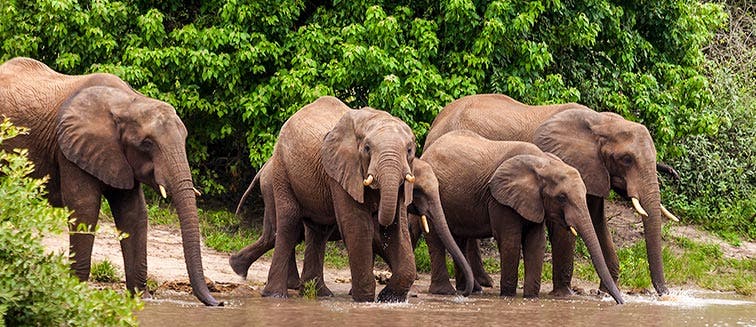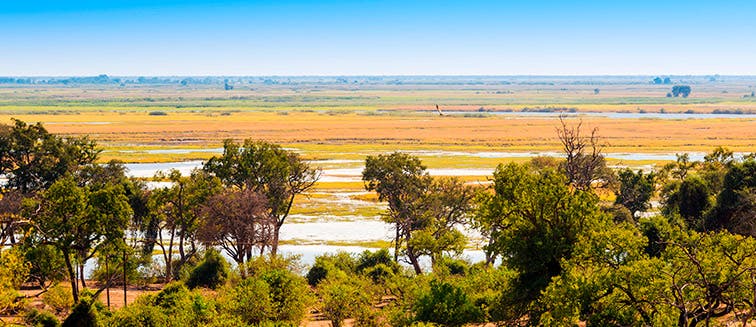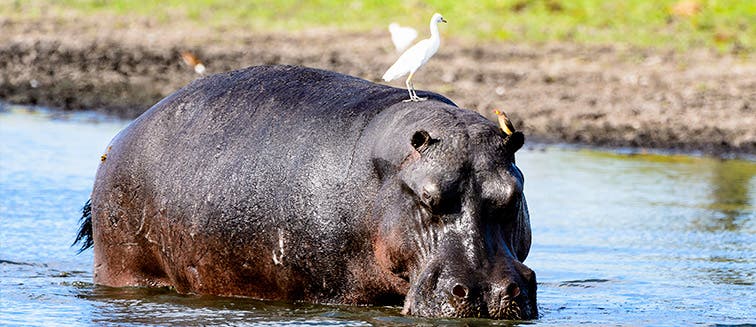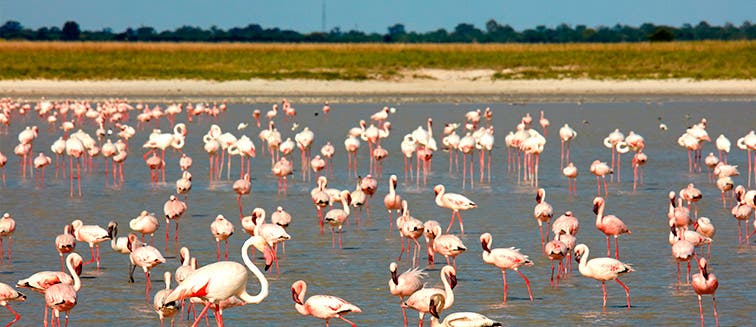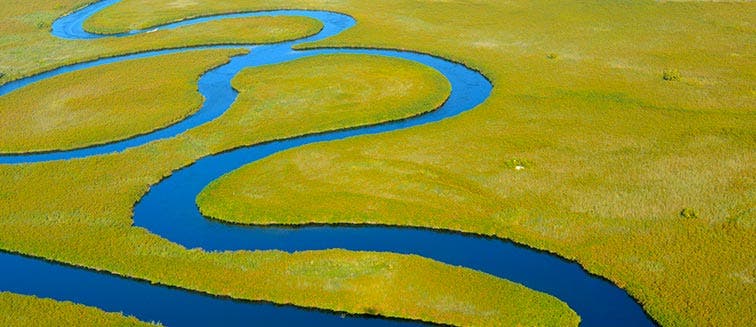Africa
Americas
Asia
Europe
Oceania
By Season
By Interest
By Group
Travel Agent Support:
+44 20 4571 6769
Monday-Friday 10 am - 19 pm
Saturday & Sunday: Closed
What to see in Botswana
Chobe National Park
Tourist attractions Chobe National Park
Stretching across more than 10,000 square metres and considered one of the best wildlife reserves in the world, Chobe National Park is famed for its huge herds of elephants and biological diversity. Located in the far north of Botswana, the park is home to the mighty Chobe River, which supports the thriving ecosystem and a rich variety of bird and wildlife. River cruises on the Chobe are one of the best ways to spot the wildlife, who every morning and evening congregate on the river banks to enjoy the glistening waters. Elephants bathe in herds in the river whilst other wildlife such as monkeys, lions, leopards, hyenas and the rare oribi antelope compete for the spoils of the rich marshlands surrounding the river. The park is home to at least 440 bird species.
The Chobe National park is at the heart of Botswana’s tourism industry, welcoming safari groups who stay in the several lodges within the park. Although most tour groups will focus on the abundant Serondela area which encompasses the Chobe Riverfront and is the sure bet for sighting wildlife, there are 3 other parts of the park that showcase the diversity of its landscapes and provide visitors with more authentic experiences. The Linyanti Marsh area is the best for sighting big cats and hippos, whereas the Savuti Marsh area, once a large inland lake that dried up due to tectonic movement, is home to large game in the dry season and phenomenal birdlife in the wetter seasons. Between these marshes lies an arid hinterland, which is often overlooked by visitors but is the best choice for sighting the rare Eland antelopes.
Declared the 1st National Park of Botswana in 1968, Chobe’s first human inhabitants were descendants of San Bushmen, a nomadic hunter-gatherer tribe whose existence can be seen in a variety of rock paintings found on hills throughout the park. These people hunted, foraged and lived in this vast land, moving with the seasons, but once the area was declared a nature reserve, they were slowly moved outside of the park’s borders as hunting was no longer allowed. By 1975, all human settlements had left the park and the ecosystem has flourished naturally ever since.
OUR BEST TRIPS TO CHOBE NATIONAL PARK
YOU ALSO LIKE
Botswana
4 Trips
Eswatini
2 Trips
Namibia
6 Trips
South Africa
13 Trips
Zimbabwe
7 Trips
Kenya
9 Trips
Tanzania
8 Trips
Ethiopia
1 Trips
Uganda
4 Trips
Mozambique
1 Trips
Senegal
Notify me when available
Rwanda
1 Trips
Morocco
3 Trips
Egypt
9 Trips
Tunisia
4 Trips
Mauritius
2 Trips
Madagascar
1 Trips
Seychelles
Notify me when available
Réunion
Notify me when available
Tourist attractions botswana
Points of interests
- Trips to Central Kalahari Game Reserve
- Trips to Chobe National Park
- Trips to Gaborone
- Trips to Ghanzi
- Trips to Kasane
- Trips to Makgadikgadi Pans
- Trips to Maun
- Trips to Moremi Game Reserve
- Trips to Okavango Delta
Other Points of interests
- Trips to Addo National Park
- Trips to Aquila Private Game Reserve
- Trips to Blyde River Canyon
- Trips to Boulder's Beach
- Trips to Cape of Good Hope
- Trips to Cape Peninsula
- Trips to Cape Town
- Trips to Deadvlei
- Trips to Dune 45
- Trips to Durban
- Trips to Eswatini
- Trips to Etosha National Park
- Trips to Fish River Canyon
- Trips to Johannesburg
- Trips to Kalahari Desert
- Trips to Kirstenbosch Botanical Garden
- Trips to Knysna
- Trips to Kruger National Park
- Trips to KwaZulu-Natal
- Trips to Lake Kariba
- Trips to Namib Desert
- Trips to Namib Naukluft
- Trips to Oudtshoorn
- Trips to Population of the Himba & Herero
- Trips to Port Elizabeth
- Trips to Pretoria
- Trips to Rovos Rail
- Trips to Santa Lucía
- Trips to Sesriem Canyon
- Trips to Skeleton Coast & Cape Cross
- Trips to Sossusvlei
- Trips to Swakopmund
- Trips to Twyfelfontein
- Trips to Victoria Falls
- Trips to Walvis Bay
- Trips to Wilderness
- Trips to Windhoek
Countries Nearby
- Botswana Trips
- Egypt Trips
- Eswatini Trips
- Ethiopia Trips
- Kenya Trips
- Madagascar Trips
- Mauritius Trips
- Morocco Trips
- Mozambique Trips
- Namibia Trips
- Réunion Trips
- Rwanda Trips
- Senegal Trips
- Seychelles Trips
- South Africa Trips
- Tanzania Trips
- Tunisia Trips
- Uganda Trips
- Zimbabwe Trips
Trip Styles
